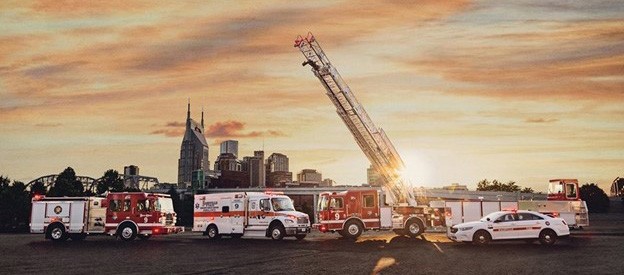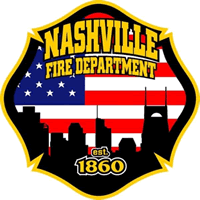 The Nashville Fire Department is one of the top 20 fire departments in the country due to the size of the population and number of emergencies. NFD is the primary provider of fire, rescue and emergency medical services for Metropolitan Nashville and Davidson County. Davidson County covers a total area of 526 square miles that encompasses a range from high density urban to wildland interface sub-areas. The department responds to more than 100,000 emergency calls per year, with a large number requiring extra alarm responses and multiple resources in over 650 high rise buildings in its jurisdiction.
The Nashville Fire Department is one of the top 20 fire departments in the country due to the size of the population and number of emergencies. NFD is the primary provider of fire, rescue and emergency medical services for Metropolitan Nashville and Davidson County. Davidson County covers a total area of 526 square miles that encompasses a range from high density urban to wildland interface sub-areas. The department responds to more than 100,000 emergency calls per year, with a large number requiring extra alarm responses and multiple resources in over 650 high rise buildings in its jurisdiction.
Our history is rich with milestones that we as Firefighters should be very proud of. Volunteers made up the ranks of the first organized department of fire when the Town on Nashville was first incorporated by the Tennessee General Assembly in 1806. We became a career department in 1860, five years before one of the most well-known and revered organizations in the world – the FDNY. Our department has provided Advanced Life Support and transport as a division since 1975. We began training Firefighters to the level of Emergency Medical Technician in 1983 when many departments in the U.S. were avoiding the inevitable. We are one of only a few Metropolitan departments in the United States, which is both a blessing and curse at times due to the amount of area we cover, and the tax structure that provides funds for operation. Fortunately we have forward-thinking leadership that has decided we should deliver the best service to the citizens of Davidson County regardless of the tax districts. We have hired and promoted minorities and females to levels as high as Deputy Chief, and we are searching beyond our county boundaries to recruit as diverse a workforce as we can. We have much to be proud of.
It is with much enthusiasm that the NFD has endeavored to increase our abilities and provide the type of service that citizens and visitors to Nashville and Davidson County can rely on. We work hard to place in service the latest design fire apparatus with the most relevant technology for our customers. We have come a long way from the early days of bucket brigades, lined up along the path from the river to the building that was on fire. The first large fire of consequence occurred in December of 1812, when all of the houses on both sides of Market Street (now known as Second Avenue) from the Square to the St. Charles Hotel were destroyed. The bucket brigade extinguished the fire after using explosives to create a gap and in that way stopped the fire from spreading.
Nashville's First Fire-Fighting Apparatus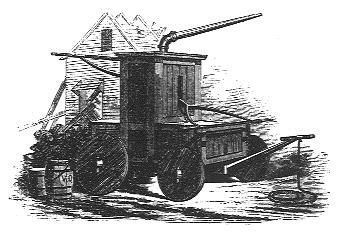
The city bought their first apparatus in 1820; a machine manufactured by Jacob Roome, in New York, and was one of the first types built in the United States. Purchase price was $750.00. It stood about three feet in height, eight feet in length, three feet wide, and two and one-half feet deep. It could throw a stream about sixty feet through a ¾ inch nozzle that was six feet long. Water was supplied to the engine by the bucket brigade. It was pulled to the fire by volunteers using two long ropes. The name of the machine was “The Cheatham”.
As mentioned before, the Fire Department became a paid career organization on July 24, 1860 under the administration of Richard B. Cheatham as Mayor, and Captain John S. Dashiell as its first Chief. The city bought three steam fire engines, all drawn by horses, with one being a four-wheeler and the other two three-wheelers. Each company was staffed with five regular men, and three runners. The runner was required to give only a part of his time to the service and throughout the day he could work at his regular trade, although they were required to report if a fire occurred and remain as long as their services were needed. At night the runners slept at the stations, reporting to the officers in charge by 9:00 PM, responding to all fires until 5:00 AM in the morning.
The City's First Motorized Fire-Fighting Apparatus
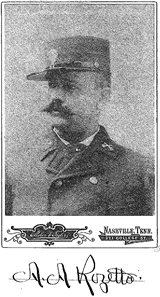 Chief Antonio Alonzo Rozetta was not the first chief of the department, but he was first to introduce motorized apparatus for service. In 1910 he purchased for the department a Marathon motorcar, produced in Nashville at 12th and Clinton. He was also the person who saw the transition from horse drawn steam pumpers to motorized steam pumpers. Chief Rozetta was named President of the International Association of Fire Engineers (IAFE), the forerunner of today’s International Association of Fire Chiefs (IAFC) in 1918.
Chief Antonio Alonzo Rozetta was not the first chief of the department, but he was first to introduce motorized apparatus for service. In 1910 he purchased for the department a Marathon motorcar, produced in Nashville at 12th and Clinton. He was also the person who saw the transition from horse drawn steam pumpers to motorized steam pumpers. Chief Rozetta was named President of the International Association of Fire Engineers (IAFE), the forerunner of today’s International Association of Fire Chiefs (IAFC) in 1918.
Dr. Thomas Woodring wrote about the Nashville Fire Department in 1939 in a manuscript full of wonderful stories that give us a glimpse of how hard it was to be a Firefighter when NFD was in its infancy. He wrote that Chief A. A. Rozetta was very fond of the service that the horses had provided to the community and each of them was special to the men who cared for them, as well as Chief Rozetta. They all had names, and in the manuscript Dr. Woodring describes how difficult it was for Chief Rozetta to retire such faithful servants. But he was a visionary that saw the benefit of a fully motorized department.
Nashville's First Fire Station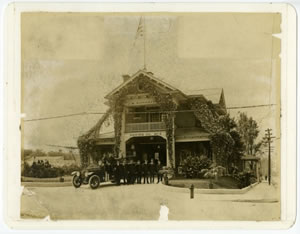
The first fire station, or fire “halls” as they are often referred to, to house these motorized pumpers is still in operation today in the East Nashville neighborhood of Lockeland Springs. It is known as Engine Company No. 14, first placed in service on October 1, 1914. The house was designed by Nashville’s first municipal architect James Yeaman and is listed on the National Historic Register of Historic Places.

The Fire of 1916
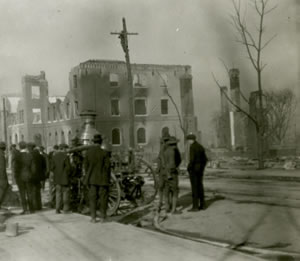 In 1916 one of the worst conflagrations in Nashville history occurred in East Nashville, burning an area of two miles long and two blocks wide, covering over 64 acres. The fire destroyed or damaged 489 buildings together with their outhouses which numbered 230, including the Edgefield Baptist Church, Woodland Street Presbyterian Church, St. Columbia’s Church and School, Warner School and Little Sisters of the Poor.
In 1916 one of the worst conflagrations in Nashville history occurred in East Nashville, burning an area of two miles long and two blocks wide, covering over 64 acres. The fire destroyed or damaged 489 buildings together with their outhouses which numbered 230, including the Edgefield Baptist Church, Woodland Street Presbyterian Church, St. Columbia’s Church and School, Warner School and Little Sisters of the Poor.
Steam Engine No. 5 was also completely destroyed, as well as several hundred feet of fire hose. The fire was intensified by a 50-mile-per-hour wind and took five hours to extinguish. 3,000 people were made homeless in that short period. Total property loss amounted to $1,553,752.53.
City and County Forms Metropolitan Government
In 1963, the city of Nashville became the Metropolitan Government of Nashville & Davidson County, combining the city and county into one entity. There are only about seventeen of these types of governments in the country. Prior to the Metropolitan Government coming into being, fire protection for the county outside the city limits was provided by private service to those residents who contracted with these for-profit vendors. The Fire Department set out to increase the number of fire stations and Firefighters to cover the additional square miles, but it would be the early 1980s before the fire service was expanded “pretty well countywide” according the Finance Director at that time. The Fire Department now had to cover 526 square miles, as opposed to 72 when it was part of the old city government.
Emergency Medical Services Added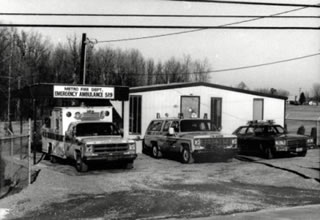
In 1974 the Nashville Fire Department began an Emergency Medical Service division. Emergency Medical Technicians and Paramedics staffed 11 ambulances for transport. It was not until 1983 that the city began training Firefighters as EMTs on the fire trucks and responding to medical calls.
The department now has 33 ambulances in service, and all 40 engine companies, 13 ladder companies, and 4 rescues respond to medical emergencies providing a comprehensive service to the community.
Nashville Fire Department Today
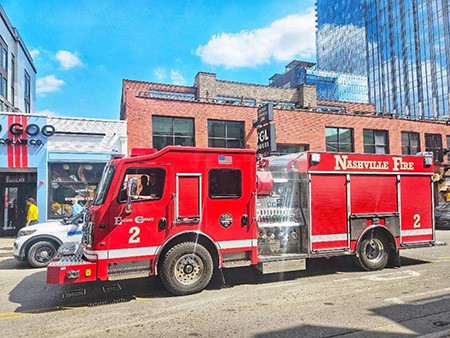
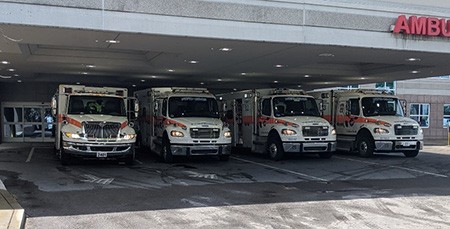
The modern Nashville Fire Department now has 39 fire stations, which house 40 engine companies (the trucks that carry water and fire pumps), 13 ladder companies to reach up to seven or eight stories of a building, 4 heavy rescue trucks and 33 ambulances. Total number of Firefighters, emergency medical technicians and paramedics along with support and administrative personnel is more than 1,500 proud members.
